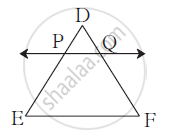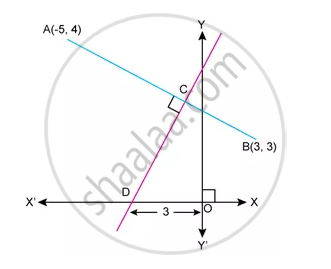Advertisements
Advertisements
प्रश्न
Find the equation of the perpendicular bisector of the line segment obtained on joining the points (6, −3) and (0, 3).
उत्तर
Let A = (6, −3) and B = (0, 3).
We know the perpendicular bisector of a line is perpendicular to the line and it bisects the line, that it, it passes through the mid-point of the line.
Co-ordinates of the mid-point of AB are
`((6 + 0)/2, (-3 + 3)/2)`
= `(6/2, 0)`
= (3, 0)
Thus, the required line passes through (3, 0).
Slope of AB = `(3 + 3)/(0 - 6) = 6/(-6) = -1`
∴ Slope of the required line = `(-1)/("slope of AB") = 1`
Thus, the equation of the required line is given by:
y − y1 = m(x − x1)
y − 0 = 1(x − 3)
y = x – 3
APPEARS IN
संबंधित प्रश्न
Write the equation of the line passing through the pair of points (2, 3) and (4, 7) in the form of y = mx + c.
If (4,-3) is a point on the line AB and slope of the line is (-2), write the equation of the line AB.
Is the line x – 3y = 4 perpendicular to the line 3x – y = 7?
Is the line 3x + 2y = 5 parallel to the line x + 2y = 1?
B(−5, 6) and D(1, 4) are the vertices of rhombus ABCD. Find the equations of diagonals BD and AC.
Find the equation of the line which is perpendicular to the line `x/a - y/b = 1` at the point where this line meets y-axis.
Show that points P(2, –2), Q(7, 3), R(11, –1) and S (6, –6) are vertices of a parallelogram.

In Δ DEF, line PQ || side EF, If DP = 2.4,
PE = 7.2, DQ = 1 then find QF.
Find Equation of CD

Find the equation of the line through the points A(–1, 3) and B(0, 2). Hence, show that the point A, B and C(1, 1) are collinear.
